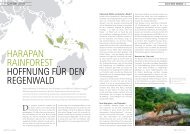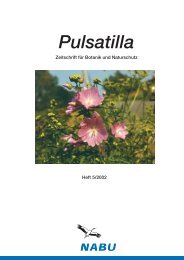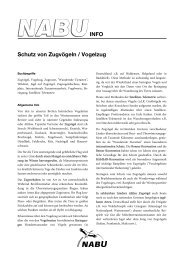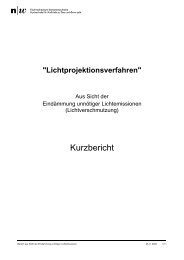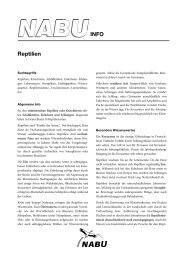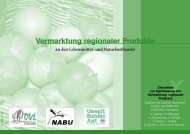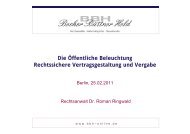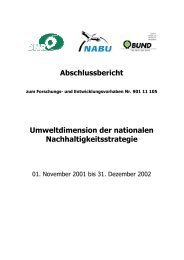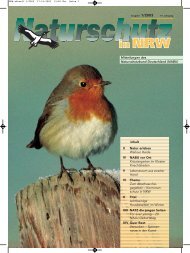Studie "The GMO-emperor has no clothes" (engl.) - Nabu
Studie "The GMO-emperor has no clothes" (engl.) - Nabu
Studie "The GMO-emperor has no clothes" (engl.) - Nabu
Create successful ePaper yourself
Turn your PDF publications into a flip-book with our unique Google optimized e-Paper software.
that GM plants have failed to deliver increased<br />
yields and have been unsuccessful in delivering<br />
any “climate ready” traits. He advocates for<br />
farming practices that build healthy soils which,<br />
in turn, require less water and use less energy<br />
than than industrial, chemical-ridden soils.<br />
Bill Freese discusses how the use of glyphosate<br />
for weed control is largely responsible for a tenfold<br />
increase in agricultural use of the herbicide<br />
in the U.S. from 1993 to 2007. 12 At 200 million<br />
pounds per year in the U.S. alone (2007), 13<br />
glyphosate is the most heavily used pesticide<br />
the world <strong>has</strong> ever seen. Freese points out that<br />
glyphosate formulations are clearly harmful to the<br />
environment and may pose human health risks as<br />
well. He cites epidemiological studies of farmers<br />
that have shown an association between contact<br />
with glyphosate herbicides and higher rates of<br />
certain cancers – <strong>no</strong>n-Hodgkin’s lymphoma, hairy<br />
cell leukemia 14 and multiple myeloma. 15 He also<br />
explores increasing contamination of GM crops to<br />
<strong>no</strong>n-GM crops and <strong>has</strong> also generated an epidemic<br />
of glyphosate-resistant weeds.<br />
Former Managing Director of Monsanto, India,<br />
Dr. T.V. Jagadisan, writes of Monsanto’s cloak<br />
and dagger business dealings in India and of the<br />
company’s aim to control India’s agriculture by<br />
controlling the country’s seed business through its<br />
wholly-owned Indian subsidiary Mahyco.<br />
He points out that many more long term trials<br />
need to be carried out by independent agencies and<br />
cautions against the scientific community rushing<br />
into GM tech<strong>no</strong>logy under the false claim of<br />
increasing production without understanding the<br />
true consequences.<br />
In the section on the History of Monsanto,<br />
dintinguished Indian scientist, architect of<br />
molecular biology and biotech<strong>no</strong>logy in India,<br />
Dr. P. M. Bhargava, gives a detailed account of<br />
Monsanto’s violations, including fraud, false<br />
reporting, harassment and intimidation, bribing<br />
officials and in one extreme case withholding<br />
of evidence about the safety of their PCBs to<br />
residents which resulted in a court finding<br />
Monsanto guilty on six counts of negligence,<br />
wantoness and suppression of the truth, nuisance,<br />
trespass and outrage.<br />
In addition to articles by these well regarded<br />
scientists, many country-specific reports provide<br />
information on <strong>GMO</strong> scientific research<br />
demonstrating many potential harms to humans<br />
and nature from this tech<strong>no</strong>logy.<br />
Movements and Resistance<br />
As these reports show, civil society movements<br />
within countries and working in global solidarity<br />
continue to expose the falsehoods of GM<br />
tech<strong>no</strong>logy. Civil society—including farmer,<br />
environmental, consumer, unions, public health<br />
and social justice groups—actions range from<br />
direct actions such as uprooting GM crops to<br />
policy and public outreach projects such as <strong>GMO</strong>-<br />
Freeze campaigns and <strong>GMO</strong> labeling initiatives. In<br />
addition, many regional governments also initiate<br />
actions and policies to halt <strong>GMO</strong>s. Networks<br />
of scientists—<strong>no</strong>tably the European Network of<br />
European Scientists for Social and Environmental<br />
Responsibility, along with the Union of<br />
Concerned Scientists (U.S. based)—provide<br />
critical technical information for civil society and<br />
governments alike.<br />
Some groups are undertaking legal actions. A<br />
few examples include: Biowatch South Africa’s<br />
challenge against Monsanto over the right to<br />
access of information about biosafety and location<br />
of several GM crop field trials: numerous legal<br />
trials in the U.S. led by the Center for Food Safety<br />
to halt or challenge commercialization of GM<br />
alfalfa, GM sugar beets, and other GM crops. In<br />
India, Navdanya <strong>has</strong> been challenging companies<br />
for stealing seed k<strong>no</strong>wledge and technical<br />
development from indige<strong>no</strong>us, tribal peoples—<br />
also k<strong>no</strong>wn as biopiracy.<br />
12<br />
U.S. Environmental Protection Agency, “Pesticides Industry Sales and Usage: Market Estimates” – see reports for<br />
1998/1999 and 2006/2007, Table 3.6 in each report, http://www.epa.gov/opp00001/pestsales/. Agricultural use of glyphosate<br />
rose from 15-20 million lbs. in 1993 to 180-185 million lbs. in 2007.<br />
13<br />
Ibid, 2006/2007 report. Agricultural use (180-185 million lbs) + home/garden use (5-8 million) + industrial/government/<br />
commercial use (13-15 million) = 198-208 million lbs. total (Tables 3.6 to 3.8).<br />
14<br />
Hardell, L., & Eriksson, M. (1999). “A Case-Controlled Study of Non-Hodgkin’s Lymphoma and Exposure to Pesticides,”<br />
Cancer, 85(6), 1353–1360; Hardell L, Eriksson M, & Nordstrom M. (2002). “Exposure to pesticides as risk factor for <strong>no</strong>n-<br />
Hodgkin’s lymphoma and hairy cell leukemia: pooled analysis of two Swedish case-control studies,” Leuk Lymphoma, 43(5),<br />
1043-1049; De Roos, et al. (2003). “Integrative assessment of multiple pesticides as risk factors for <strong>no</strong>n-Hodgkin’s lymphoma<br />
among men,” Occup Environ Med, 60(9).<br />
15<br />
De Roos, A. J. D., Blair, A., Rusiecki, J. A., Hoppin, J. A., Svec, M., Dosemeci, M., Sandler, D. P., & Alavanja, MC (2005).<br />
Cancer Incidence among Glyphosate Exposed Pesticide Applicators in the Agricultural Health Study. Environmental Health<br />
Perspectives, 113(1), 49-54.<br />
32



